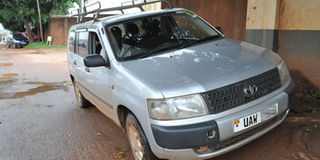Effects of bad parking on your tyres

Parking with part of the tyre off the pavement will damage it over time . PHOTO by Rachel Mabala.
What you need to know:
Because of limited parking space, some drivers will fit their car in any spot even when part of the tyre is hanging in space. Roland Nasasiira talked to experts on the effects of bad parking.
On several occasions, I have found vehicles parked by the roadside and some of these have been squeezed in a very small space. Sometimes, either one or two tyres will be on a raised pavement, making the car appear bent. At times, they are parked this way for a short time while others take even a whole day.
Swelling
Much as you are trying to work within the alloted space, this could come at a cost. When you park your car in such a way, Peterson Kasoma, a car tyre mechanic at Shell Jinja Road fuel station, explains; “The tyres develop swellings and also get torn from the inside. The tyres were manufactured in a way that part of the tyre tread area is not hard enough to stand on its own for a long time. And in situations where the pavement is made of small sharp stones, they exert pressure on the tyre and soon will wear out.”
Damage the tyre
Kasoma also notes that when a car is parked on small stones, they (stones) can get stuck between the tyre treads. When the car is in motion and the stones don’t move out on their own, they slowly penetrate the tyre until it is entirely damaged.
Tear and wear
During the rainy season, sometimes drivers without any available options decide to park in pools of water, all with a mindset that water cannot penetrate through rubber to affect the tyres. “In this situation, if one or all the tyres had small punctures and the driver is not aware, the water that enters the tyres rusts the metal wires that hold the rubber together and with time, the tyre wears out completely.”
Kasoma explains that when one drives with such a tyre, sometimes it is characterised by irregular tyre movements that can be felt when a car is in motion.
He explains further that rain water collects a lot of rubbish, including old rusty nails and other dangerous metals.
“When you park in dirty rain water, you don’t see what is beneath it. These metals easily penetrate the tyre and pierce it and can go upto the tube just like the ease with which an injection penetrates a human skin when it has been wiped with wet cotton wool.”
Wrong parking
Enock Kijali, a street car parking controller with Multiplex Parking Control Limited, says,
“You should park your car and make sure it fits in the space provided because they are big enough. The spaces were made in a way that a motorist parks his/her car and there is space left for them to vacate the place even if there is another person parked in the adjacent box,” Kijali explains, adding that if someone parks so close to the next car and the person they found already parked cannot get out their car, their car is clamped for wrong parking.
Uphill and downhill parking
Jackson Mugisha, a mechanic at CKK Garage in Wandegeya explains that when parking a car facing downhill, the front tyres should be adjusted to face sideways. “The tyres should face in a different direction such that incase the handbrake loosens, the car can control itself and does not cause terrible accidents. But if it’s parked facing downhill on a busy road, all the tyres should be straight and a stopper placed beneath the tyres to control any movements even if the handbrake loosens,” Mugisha further explains.
He points out “If a car is parked facing uphill, the tyres should be straight and stoppers placed beneath them because there are situations when the roads are narrow and other road users may knock the tyres unknowingly if they face sideways.”




